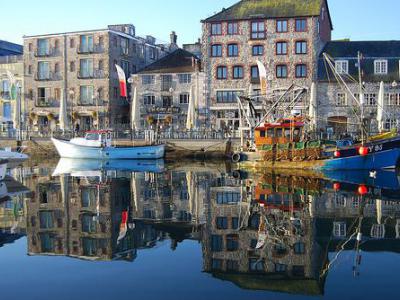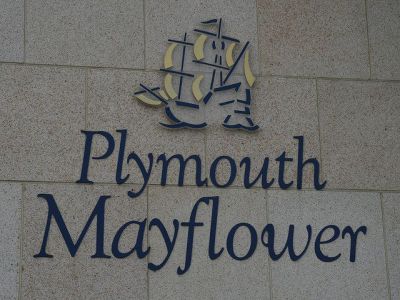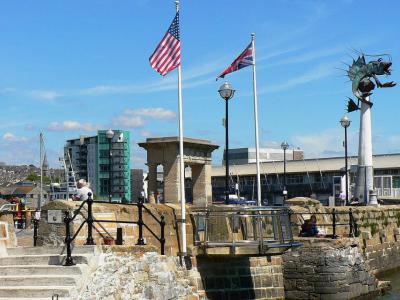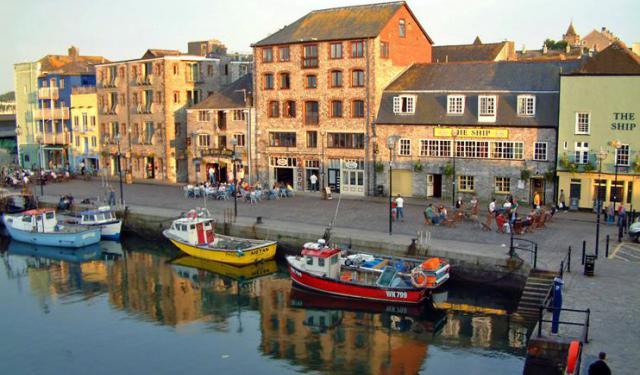
Pilgrim Fathers Trail (Self Guided), Plymouth
Back in the early 17th century, a group of English Puritans – nowadays reverently referred to as the Pilgrim Fathers – fled religious persecution in their homeland and established a colony in North America that later became known as Plymouth, Massachusetts. The Pilgrims embarked on their perilous journey across the Atlantic from Plymouth, England in 1620 aboard a ship called the Mayflower, which today is famously remembered as the Mayflower voyage.
The memory of that epic crossing lives on in the English city of Plymouth where several sites associated with the Pilgrim Fathers are still in place and attract history buffs from all over the world to this day.
The historic heart of Plymouth's fishing industry – Sutton Harbour – is now a bustling waterfront area with a marina, restaurants, and shops. The located here Mayflower Steps are said to be the place from where the Mayflower set sail for America. A bronze plaque on the steps commemorates that event.
Another historic location, the 16th-century Elizabethan House, is where some of the Pilgrims lodged while their other fellows stayed at the nearby Island House awaiting their departure for North America.
The Plymouth Gin Distillery – the oldest working gin distillery in England – is where the Pilgrims enjoyed their final drink prior to boarding the Mayflower. The full story of the Pilgrim Fathers' voyage, including their struggle to survive in the New World, and their legacy in American history, can be learned at the Mayflower Museum located in Plymouth's waterfront area, not far away.
The fact that, upon their arrival in America, the Pilgrims chose to call their newly-established colony “Plymouth”, gives us reasons to assume that despite the years of persecution and the hardships they endured, the time they had spent in this coastal English town was something worth remembering in the new life awaited them on the new continent. To see what may have impressed the Pilgrims so much in Plymouth, UK, take this self-guided walk and find out.
The memory of that epic crossing lives on in the English city of Plymouth where several sites associated with the Pilgrim Fathers are still in place and attract history buffs from all over the world to this day.
The historic heart of Plymouth's fishing industry – Sutton Harbour – is now a bustling waterfront area with a marina, restaurants, and shops. The located here Mayflower Steps are said to be the place from where the Mayflower set sail for America. A bronze plaque on the steps commemorates that event.
Another historic location, the 16th-century Elizabethan House, is where some of the Pilgrims lodged while their other fellows stayed at the nearby Island House awaiting their departure for North America.
The Plymouth Gin Distillery – the oldest working gin distillery in England – is where the Pilgrims enjoyed their final drink prior to boarding the Mayflower. The full story of the Pilgrim Fathers' voyage, including their struggle to survive in the New World, and their legacy in American history, can be learned at the Mayflower Museum located in Plymouth's waterfront area, not far away.
The fact that, upon their arrival in America, the Pilgrims chose to call their newly-established colony “Plymouth”, gives us reasons to assume that despite the years of persecution and the hardships they endured, the time they had spent in this coastal English town was something worth remembering in the new life awaited them on the new continent. To see what may have impressed the Pilgrims so much in Plymouth, UK, take this self-guided walk and find out.
How it works: Download the app "GPSmyCity: Walks in 1K+ Cities" from Apple App Store or Google Play Store to your mobile phone or tablet. The app turns your mobile device into a personal tour guide and its built-in GPS navigation functions guide you from one tour stop to next. The app works offline, so no data plan is needed when traveling abroad.
Pilgrim Fathers Trail Map
Guide Name: Pilgrim Fathers Trail
Guide Location: England » Plymouth (See other walking tours in Plymouth)
Guide Type: Self-guided Walking Tour (Sightseeing)
# of Attractions: 6
Tour Duration: 1 Hour(s)
Travel Distance: 0.5 Km or 0.3 Miles
Author: VictoriaB
Sight(s) Featured in This Guide:
Guide Location: England » Plymouth (See other walking tours in Plymouth)
Guide Type: Self-guided Walking Tour (Sightseeing)
# of Attractions: 6
Tour Duration: 1 Hour(s)
Travel Distance: 0.5 Km or 0.3 Miles
Author: VictoriaB
Sight(s) Featured in This Guide:
- Sutton Harbour
- Plymouth Gin Distillery
- Elizabethan House
- Island House
- Mayflower Museum
- Mayflower Steps
1) Sutton Harbour
Previously known as "Sutton's Pool," Sutton Harbour is the original port of Plymouth. The port has expanded, but the old Harbour remains a busy fishing port and marina. It is part of the Barbican district of town and was the departure point of the Mayflower, carrying passengers and cargo to the New World.
Plymouth was settled as early as 700 AD. Sutton (southern settlement) was the original name for the town, taken from the Domesday Book (a comprehensive record of land in England, made in 1086 by order of William I). Sutton Harbour was the base of the English fleet that challenged the Spanish Armada. The Navy moved to Devonport, but fishing vessels and coastal carriers remained.
The Barbican borders the north and west ends of the harbor. It is named for the 15th-century fortification that formerly guarded the mouth of the Harbour. The district boasts of having the most cobbled streets in England. Over a hundred buildings date from the 16th and 17th centuries.
The Mayflower Steps, where the Pilgrims took ship for America in 1620, are marked by a porticoed platform on the West Pier of Sutton Harbour. Also on the West Pier is the Leviathan, a sculpture of an imaginary sea monster by artist and sculptor Brian Fell. It is 33 feet tall. Locals call it the Prawn.
The National Marine Aquarium of Plymouth, the largest in the UK, is located in the Barbican near the Royal Citadel. It has over 400 marine species.
Sutton Harbour is also a vibrant waterfront with a selection of luxury waterside properties, modern offices, a diverse range of restaurants, cafes, bars, shops, and year-round visitor attractions.
Plymouth was settled as early as 700 AD. Sutton (southern settlement) was the original name for the town, taken from the Domesday Book (a comprehensive record of land in England, made in 1086 by order of William I). Sutton Harbour was the base of the English fleet that challenged the Spanish Armada. The Navy moved to Devonport, but fishing vessels and coastal carriers remained.
The Barbican borders the north and west ends of the harbor. It is named for the 15th-century fortification that formerly guarded the mouth of the Harbour. The district boasts of having the most cobbled streets in England. Over a hundred buildings date from the 16th and 17th centuries.
The Mayflower Steps, where the Pilgrims took ship for America in 1620, are marked by a porticoed platform on the West Pier of Sutton Harbour. Also on the West Pier is the Leviathan, a sculpture of an imaginary sea monster by artist and sculptor Brian Fell. It is 33 feet tall. Locals call it the Prawn.
The National Marine Aquarium of Plymouth, the largest in the UK, is located in the Barbican near the Royal Citadel. It has over 400 marine species.
Sutton Harbour is also a vibrant waterfront with a selection of luxury waterside properties, modern offices, a diverse range of restaurants, cafes, bars, shops, and year-round visitor attractions.
2) Plymouth Gin Distillery (must see)
Located in the Barbican district of Plymouth, the Plymouth Gin Distillery dates from the early 1400s. The most intact part of the distillery is the Refectory Room, a medieval hall with a fine hull-shaped timber roof built in 1431. It is one of the oldest buildings in Plymouth, protected as a precious national monument. It is said that the Distillery buildings were once a monastery of the Dominican Black Friars.
In 1536 the Black Friars monastery fell victim to the storms of the Reformation. The monastery was dissolved, and the buildings were used as a Marshalsea (debtors' prison). It was later a non-Conformist meeting hall and a haven for Huguenot refugees fleeing France.
According to local legend, in 1620, some Pilgrim Fathers spent their last night in England at the old monastery while their ship, Mayflower, was in the harbor for repairs before finally setting sail to North America. This is where the Mayflower on Plymouth Gin's trademark originated.
Black Friars has had a working gin distillery on the premises since 1697. In 1793, the distillery of Coates & Company was joined by the firm of Fox & Williamson. The business retained the name of Coates & Company. In 2005 the firm was acquired by the Swedish company V&S Group and later by the French company Pernod-Ricard.
Plymouth Gin is an actual brand name and may only be produced in the town of Plymouth. The distillery fought several legal battles to preserve its reputation. The gin had become the official gin of the British Royal Navy officers' messes. For almost 200 years, a navy ship would never leave port without a bottle of Plymouth Navy strength Gin onboard.
In 1536 the Black Friars monastery fell victim to the storms of the Reformation. The monastery was dissolved, and the buildings were used as a Marshalsea (debtors' prison). It was later a non-Conformist meeting hall and a haven for Huguenot refugees fleeing France.
According to local legend, in 1620, some Pilgrim Fathers spent their last night in England at the old monastery while their ship, Mayflower, was in the harbor for repairs before finally setting sail to North America. This is where the Mayflower on Plymouth Gin's trademark originated.
Black Friars has had a working gin distillery on the premises since 1697. In 1793, the distillery of Coates & Company was joined by the firm of Fox & Williamson. The business retained the name of Coates & Company. In 2005 the firm was acquired by the Swedish company V&S Group and later by the French company Pernod-Ricard.
Plymouth Gin is an actual brand name and may only be produced in the town of Plymouth. The distillery fought several legal battles to preserve its reputation. The gin had become the official gin of the British Royal Navy officers' messes. For almost 200 years, a navy ship would never leave port without a bottle of Plymouth Navy strength Gin onboard.
3) Elizabethan House
Tucked away on a narrow cobbled path, some 20 minutes away from the Barbican marina, is a beautifully preserved 16th-century property called Elizabethan House. New Street, where the house is located, has a deceptive name as it was actually built between 1575 and 1600, when Plymouth was a thriving port.
Now one of Plymouth’s oldest buildings, Elizabethan House was built as a letting property and has been lived in by many people whose lives and livelihoods were based around the waterfront. Rescued from demolition in 1929, it survives in its near original state and as such is a rare example of its time with centuries of stories to tell, from the 1500s to the early 1900s.
In 2020/2021, Elizabethan House underwent a major restoration as part of Plymouth’s Mayflower 400 commemorations, co-funded by Plymouth City Council, Mayflower 400, and other donors.
The ancient doorway at No.32 invites visitors to an authentic journey back to the times of Sir Francis Drake and The Pilgrim Fathers – a bit like the film set, with all the original furnishings and artifacts of the time, and interactives similar to those at the Mayflower Museum not far away. Guided tours are available and last about 45 minutes.
With visual and sound effects, the house has been turned into an immersive experience enabling visitors to actually "meet" its former residents. What kind of people were tenants here? There were lace workers, sailors, laundresses, wig-makers, and undertakers. Three Plymouth mayors resided here, too, including the privateer William Parker, a familiar of Francis Drake and a scourge of the Caribbean.
The house has seven rooms on three floors. The curator meets visitors at the door and leads them into the first room. The house itself can speak, with the voice of a 90-year-old Plymothian who was actually born in New Street. She shares her memories with visitors as they are led through each of the carefully restored rooms.
Now one of Plymouth’s oldest buildings, Elizabethan House was built as a letting property and has been lived in by many people whose lives and livelihoods were based around the waterfront. Rescued from demolition in 1929, it survives in its near original state and as such is a rare example of its time with centuries of stories to tell, from the 1500s to the early 1900s.
In 2020/2021, Elizabethan House underwent a major restoration as part of Plymouth’s Mayflower 400 commemorations, co-funded by Plymouth City Council, Mayflower 400, and other donors.
The ancient doorway at No.32 invites visitors to an authentic journey back to the times of Sir Francis Drake and The Pilgrim Fathers – a bit like the film set, with all the original furnishings and artifacts of the time, and interactives similar to those at the Mayflower Museum not far away. Guided tours are available and last about 45 minutes.
With visual and sound effects, the house has been turned into an immersive experience enabling visitors to actually "meet" its former residents. What kind of people were tenants here? There were lace workers, sailors, laundresses, wig-makers, and undertakers. Three Plymouth mayors resided here, too, including the privateer William Parker, a familiar of Francis Drake and a scourge of the Caribbean.
The house has seven rooms on three floors. The curator meets visitors at the door and leads them into the first room. The house itself can speak, with the voice of a 90-year-old Plymothian who was actually born in New Street. She shares her memories with visitors as they are led through each of the carefully restored rooms.
4) Island House
Records indicate that Island House dates from 1572. It is known for being the last place of accommodation for Pilgrim Fathers on the eve of their final departure on the Mayflower for North America. Before their trip, the travelers were sheltered in Plymouth since one of their ships, the Speedwell, required essential repairs. The voyage continued on the Mayflower.
The Island House may not have been known as Island House at that time, but it was so-called on the earliest surviving deeds of 1718. Mr. John Bayly bought Island House from Sir William Molesworth in 1786. The house remained in the Bayly family.
A blue plaque dated 1976 is located outside a shop on the ground floor of the Island House. It reads: "...one of the houses where a group of English puritans, since known as the Pilgrim Fathers, were entertained ashore before their final departure for America on the 6th September 1620 in the Mayflower."
The Island House may not have been known as Island House at that time, but it was so-called on the earliest surviving deeds of 1718. Mr. John Bayly bought Island House from Sir William Molesworth in 1786. The house remained in the Bayly family.
A blue plaque dated 1976 is located outside a shop on the ground floor of the Island House. It reads: "...one of the houses where a group of English puritans, since known as the Pilgrim Fathers, were entertained ashore before their final departure for America on the 6th September 1620 in the Mayflower."
5) Mayflower Museum
The Mayflower Museum is located at 3-5 the Barbican in Plymouth. It sits above the Tourist Information Centre. It is open from 9 am to 5 pm, Mondays through Saturdays, and 10 am to 4 pm on Sundays. The Museum has reopened after an extensive remaking of its exhibits and displays. The Box is a new multi-million-pound cultural and heritage attraction.
Exhibitions on three floors examine the Mayflower company of explorers and Pilgrims and their contacts with the indigenous people of the Wampanoag Nation. There is an introduction to native history and culture alongside English voyages to America.
The exhibits, including animations and photography, were developed by the New England Historic Genealogical Society of Boston and SmokeSygnals, the Wampanoag cultural society. There are cartoons, sound effects, and hands-on displays. There is also a three-foot high 1:11-inch scale model of the ship Mayflower.
A new children's trail helps young visitors to learn about Wampanoag life, art, and the impact of the Mayflower and its passengers.
Exhibitions on three floors examine the Mayflower company of explorers and Pilgrims and their contacts with the indigenous people of the Wampanoag Nation. There is an introduction to native history and culture alongside English voyages to America.
The exhibits, including animations and photography, were developed by the New England Historic Genealogical Society of Boston and SmokeSygnals, the Wampanoag cultural society. There are cartoons, sound effects, and hands-on displays. There is also a three-foot high 1:11-inch scale model of the ship Mayflower.
A new children's trail helps young visitors to learn about Wampanoag life, art, and the impact of the Mayflower and its passengers.
6) Mayflower Steps
On 22 July 1620, the ship Speedwell set sail from Holland, bound for Southampton, England. Speedwell had to join up with the ship Mayflower. The two ships would then sail together for North America. Due to bad weather in the English Channel, Speedwell was anchored in Plymouth, seeking shelter and essential repairs. The Gin Distillery and the Island House had accommodated the passengers before sailing for one or more nights.
Speedwell was declared unfit. Some of the passengers were to go on the Mayflower. On a morning in early September 1620, the Puritan and Separatist passengers walked down to the quayside steps and boarded the Mayflower, commanded by Christopher Jones. The wind was good, and they set out to meet their destiny.
The Mayflower Steps are located on the West Pier in the Barbican section of Plymouth. The actual site of departure is the best estimate, based upon where the Victorian public house, Admiral MacBride, stands today. These days, boat trips leave the steps for tours up Plymouth Sound and the River Tamar "Dockyard and Warships."
The departure site is marked by a portico of Doric columns made from Portland stone. The memorial, built in 1934, sits on a small pier from the 19th century. A railed platform over the water is holding a bronze memorial plaque.
Speedwell was declared unfit. Some of the passengers were to go on the Mayflower. On a morning in early September 1620, the Puritan and Separatist passengers walked down to the quayside steps and boarded the Mayflower, commanded by Christopher Jones. The wind was good, and they set out to meet their destiny.
The Mayflower Steps are located on the West Pier in the Barbican section of Plymouth. The actual site of departure is the best estimate, based upon where the Victorian public house, Admiral MacBride, stands today. These days, boat trips leave the steps for tours up Plymouth Sound and the River Tamar "Dockyard and Warships."
The departure site is marked by a portico of Doric columns made from Portland stone. The memorial, built in 1934, sits on a small pier from the 19th century. A railed platform over the water is holding a bronze memorial plaque.
Walking Tours in Plymouth, England
Create Your Own Walk in Plymouth
Creating your own self-guided walk in Plymouth is easy and fun. Choose the city attractions that you want to see and a walk route map will be created just for you. You can even set your hotel as the start point of the walk.
Plymouth Introduction Walking Tour
Plymouth's early history began in the Bronze Age when the first settlement emerged at Mount Batten. It is mentioned in Ptolemy's Geographia as a maritime outpost exporting bronze mirrors.
The settlement was a major port in the southwest of England in Roman times. It was surpassed as a port in the ninth century by the nearby wealthier village of Sutton, later called Plymouth.
... view more
Tour Duration: 1 Hour(s)
Travel Distance: 1.9 Km or 1.2 Miles
The settlement was a major port in the southwest of England in Roman times. It was surpassed as a port in the ninth century by the nearby wealthier village of Sutton, later called Plymouth.
... view more
Tour Duration: 1 Hour(s)
Travel Distance: 1.9 Km or 1.2 Miles
Plymouth Hoe Walking Tour
Plymouth Hoe, referred to locally as the Hoe, is a large south-facing open public space in Plymouth with commanding views of Plymouth Sound, Drake's Island, and further afield into Cornwall. The name derives from the Anglo-Saxon word hoh, which means a sloping ridge shaped like an inverted foot and heel.
This part of town has always been a meeting place, where people would come regularly... view more
Tour Duration: 1 Hour(s)
Travel Distance: 0.7 Km or 0.4 Miles
This part of town has always been a meeting place, where people would come regularly... view more
Tour Duration: 1 Hour(s)
Travel Distance: 0.7 Km or 0.4 Miles
The Most Popular Cities
/ view all








